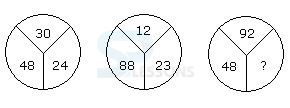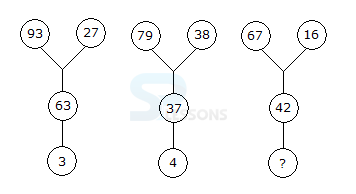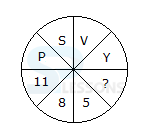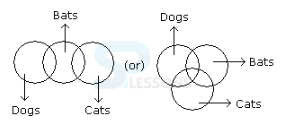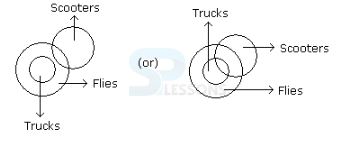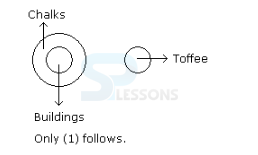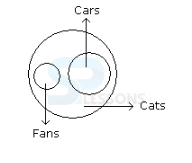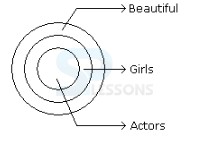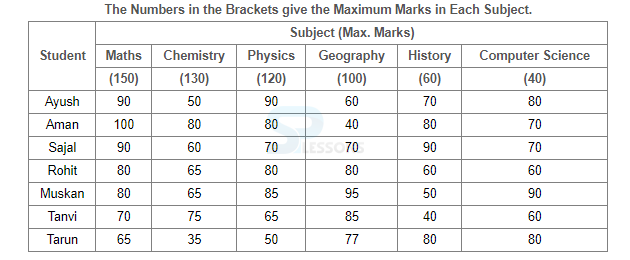 Introduction
Introduction
IDBI Assistant Manager (AM) Online Test, will comprise of Objective Tests for 200 marks consisting of 4 Sections as follows. A composite time of 2 Hours will be given for answering the questions for the Objective tests. The below sections gives the detailed information about IDBI Assistant Manager Logical Reasoning Section.
 Pattern
Pattern
| S.No. | Name of Tests | No. of Questions | Maximum Marks | Duration |
|---|---|---|---|---|
| 1 | Logical Reasoning, Data Analysis & Interpretation | 60 | 60 | Composite time of 2 Hours |
| 2 | English Language | 40 | 40 | |
| 3 | Quantitative Aptitude | 40 | 40 | |
| 4 | General/ Economy/ Banking Awareness | 60 | 60 |
 Syllabus
Syllabus
[Click Here] for IDBI Assistant Manager Online Test Syllabus
Note:
For each question for which a wrong answer has been given by the candidate, one fourth or 0.25 of the marks assigned to that question will be deducted as penalty to arrive at corrected score. If a question is left blank, i.e. no answer is marked by the candidate; there will be no penalty for that question.
 Samples
Samples
Coded Inequalities
Directions (1-5):
‘P $ Q’ means ‘P is not smaller than Q’
‘P @ Q’ means ‘P is neither smaller than nor equal to Q’
‘P # Q’ means ‘P is neither greater than nor equal to Q’
‘P & Q’ means ‘P is neither greater than nor smaller than Q’
‘P * Q’ means ‘P is not greater than Q’
1. statements:
H @ T, T # F, F& E, E * V
Conclusions:
I. V $ F
II. E @ T
III. H @ V
IV. T # V
-
A. Only I, II, and III are true
B. Only I, II, and IV are true
C. Only II, III, and IV are true
D. Only I, III, and IV are true
E. All I, II, III, and IV are true
-
A. Only I, II, and III are true
B. Only II, III, and IV are true
C. Only I, III, and IV are true
D. All I, II, III, and IV are true
E. None of these
-
A. Only I is true
B. Only III is true
C. Only IV is true
D. Only either III or IV are true
E. Only either III or IV and I are true
-
A. None is true
B. Only I is true
C. Only II is true
D. Only III is true
E. Only IV is true
-
A. Only I and II are true
B. Only III and IV are true
C. Only III or IV are true
D. Only II, III, and IV are true
E. None of these
-
A. Father
B. Grand Father
C. Mother
D. Can’t be determined
E. None of these
-
A. Son
B. Grandson
C. Daughter
D. Granddaughter
E. None of these
-
A. Brother
B. Son-in-law
C. Son
D. Brother-in-law
E. None of these
-
A. Father
B. Brother
C. Sister
D. Mother
E. None of these
-
A. Two
B. Three
C. Four
D. Can’t be determined
-
A. SGHMJ
B. UIJOL
C. UHNKI
D. UJKPM
-
A. Garnet
B. Ruby
C. Pukhraj
D. Pearl
-
A. Museum
B. Stone
C. Chisel
D. Statue
-
A. Pyorrhoea
B. Cataract
C. Trachoma
D. Eczema
-
A. Reporter
B. Distributor
C. Printer
D. Editor
-
A. MUDIATS
B. MUDIAST
C. MUIDATS
D. MIUDATS
E. ATSDMUI
-
A. HPEISAPNS
B. HPISEAPNS
C. HPIESPANS
D. HPIESAPNS
E. APNSSEIPH
-
A. UCCAETAR
B. UACCETAR
C. UCACETAR
D. UCCATEAR
E. UCAAECTR
-
A. Not the electric do touch open wires
B. Do not touch the electric open wires
C. Do not touch the open electric wires
D. Not the do electric touch open wires
E. None of these
-
A. NUMMCER
B. NUNMCER
C. NTNMCFR
D. NTMMCFR
E. None of these
-
A. Any two of the three
B. Only I and II
C. Only II and III
D. All I, II and III
E. Only II and either I or III
-
A. Only I and II
B. Only II and III
C. Only I and III
D. All I, II and III
E. None of these
-
A. Only I and II
B. Only II and III
C. All I, II and III
D. Only I and either II or III
E. None of these
-
A. Only I and II
B. Only II and III
C. Only I and III
D. All I, II and III
E. None of these
-
A. Only I
B. Only I and II
C. Only II and III
D. Only I and III
E. None of these
Input and Output
Directions (1-5): Study the following information carefully to answer the given questions.
A word and number arrangement machine when given an input line of words and numbers rearranges them following a particular rule in each step. The following is an illustration of input and rearrangement.
Input: Prone nine 36 49 angles 66 crows 64 ideate Choose 54 51
Step I: Choose 1 Pronenine 49angle 66crow 64 ideate 54 51
Step II: Choose 1 ideate 29 Prone nine angle 66 crow 64 54 51
Step III: Choose 1 ideate 29 Prone31 nine angle 66 crow 64 54
Step IV: Choose 1 ideate 29 Prone 31 Crow 39 nine angle 66 64
Step V: Choose 1 ideate 29 Prone 31 Crow 39 nine 50 angles 66
Step VI: Choose 1 ideate 29 Prone 31 Crow 39 nine 50 angles 60
Step VI is the last step, find out in each of the rules followed in the above steps, find out in each of the following questions the appropriate step for the given input
Input: Ware 33 watch 38gonenook 5132 cast feat 50 64.
1. After how many steps no further rearrangement of words is possible?
-
A. Six
B. Four
C. Five
D. Seven
E. Eight
-
A. Ware
B. 44
C. 32
D. 50
E. None of these
-
A. Eleventh from the left
B. Second from the right
C. Tenth from the left
D. First from the left
E. None of these
-
A. Step V, ware
B. Step V, cast
C. Step IV, ware
D. Step IV, cast
E. None of these
-
A. Sixth from right
B. Seventh from right
C. Seventh from left
D. Third from right
E. None of these
-
A. Immediate left
B. Third to the right
C. Third to the left
D. Second to the right
E. Fourth to the left
- A. B
B. C
C. E
D. G
E. H
-
A. Immediate right
B. Third to the right
C. Third to the left
D. Second to the left
E. Fourth to the left
-
A. One
B. Two
C. Three
D. Four
E. More than four
-
A. F
B. C
C. E
D. H
E. G
-
A. North-East
B. West
C. South
D. East
-
A. North
B. West
C. South
D. East
-
A. North
B. West
C. South
D. East
-
A. North
B. West
C. South
D. East
-
A. South-East
B. South-West
C. North-East
D. North-West
-
A. D1
B. D6
C. D2
D. D3
E. None of these
-
A. 11 km
B. 13 km
C. 7 km
D. 12 km
E. 9 km
-
A. A – D8 – 6 km
B. F – D2 – 4 km
C. B – D8 – 7 km
D. H – D7 – 13 km
E. None of these
-
A. Restaurant D is 15 km away
B. Dish D5 is served in Restaurant F
C. Restaurant H is 11 km away
D. Restaurant B is 6 km away
E. All are true
-
A. 7 km
B. 4 km
C. 9 km
D. 11 km
E. 13 km
-
A. 62
B. 63
C. 64
D. 60
E. None of these
-
A. 26
B. 27
C. 28
D. 25
E. None of these
-
A. 25
B. 30
C. 28
D. 20
E. None of these
-
A. Anirudh
B. Karan
C. Kuldeep
D. Gunjesh
E. None of these
-
A. Lalit
B. Aditya
C. Sandeep
D. Ashish
E. None of these
Linear Seating Arrangement
Directions (1 - 5): Read the given information carefully and answer the questions given beside:
Nine persons – Chaya, Dimple, Beena, Ajit, Jaya, Fatima, Gagan, Hemant and Kaushal – are sitting in a straight line facing north, but not necessarily in the same order.
Beena is fourth to the left of Gagan; Fatima is fourth to the right of Chaya and second to the left of Kaushal, who is fifth to the right of Ajit. Dimple is not an immediate neighbor of either Kaushal or Beena. There are only three persons between Jaya and Ajit. Gagan is second to the right of Chaya.
1. In which of the following combinations is the third person sitting between the first and the second person?
-
A. Jaya, Kaushal, Beena
B. Chaya, Hemant, Beena
C. Ajit, Gagan, Chaya
D. Fatima, Gagan, Dimple
E. None of these
-
A. Gagan
B. Dimple
C. Jaya
D. Beena
E. None of these
-
A. Kaushal
B. Gagan
C. Dimple
D. Beena
E. None of these
-
A. Ajit, Dimple
B. Hemant, Jaya
C. Kaushal, Beena
D. Chaya, Kaushal
E. None of these
-
A. Chaya
B. Jaya
C. Beena
D. Ajit
E. None of these
-
A. 46
B. 60
C. 75
D. 86
-
A. 5
B. 6
C. 8
D. 9
-
A. 2
B. 3
C. 6
D. 7
-
A. 3
B. 5
C. 7
D. 9
-
A. 4
B. 8
C. 16
D. 32
-
A. Only (1) conclusion follows
B. Only (2) conclusion follows
C. Either (1) or (2) follows
D. Neither (1) nor (2) follows
E. Both (1) and (2) follow
-
A. Only (1) conclusion follows
B. Only (2) conclusion follows
C. Either (1) or (2) follows
D. Neither (1) nor (2) follows
E. Both (1) and (2) follow
-
A. Only (1) conclusion follows
B. Only (2) conclusion follows
C. Either (1) or (2) follows
D. Neither (1) nor (2) follows
E. Both (1) and (2) follow
-
A. Only (1) conclusion follows
B. Only (2) conclusion follows
C. Either (1) or (2) follows
D. Neither (1) nor (2) follows
E. Both (1) and (2) follow
-
A. Only (1) conclusion follows
B. Only (2) conclusion follows
C. Either (1) or (2) follows
D. Neither (1) nor (2) follows
E. Both (1) and (2) follow
-
A. Jet Airways
B. Indigo
C. Air India
D. Spice Jet
E. Can't be determined
- A. 09:00 am
B. 01:00 pm
C. 11:00 am
D. 12:00 am
E. 07:00 am
- A. Two
B. Four
C. Five
D. Three
E. None of the above
- A. Flight of Air India
B. Flight for Surat
C. Flight for Delhi
D. Flight of Vistara
E. Can't be determine
-
A. Indigo
B. Spice Jet
C. Go Air
D. Vistara
E. Jet Airways
-
A. 77.26
B. 89.14
C. 91.37
D. 96.11
-
A. 1
B. 2
C. 3
D. None
-
A. 409
B. 419
C. 429
D. 449
-
A. 52.5%
B. 55%
C. 60%
D. 63%
-
A. Maths
B. Chemistry
C. Physics
D. History






